Planet Earth, our shared cradle of life, is brimming with wonders and mysteries. However, some of the recent revelations about our home planet paint a picture of unprecedented changes and challenges. Here are five such extraordinary findings: 1. Antarctica’s Unprecedented Heatwave: 2022 marked the year when Antarctica experienced the most extreme heatwave ever recorded on … Continue reading 5 Astonishing Discoveries about Planet Earth
Allen’s rule describes a pattern in animals…
Allen’s rule describes a pattern in animals’ lankiness and size (surface-area to volume ratio) across related species, where hotter climates yield skinny or small animals whereas colder climates yield bulky or large animals.
The post Allen’s rule describes a pattern in animals… appeared first on Crazy Facts.
Record Cold Temperatures Don’t Mean Climate Change Isn’t Taking Place
It’s cold outside! Really cold!
We aren’t even into December yet, but much of the country has already seen frigid temperatures and huge snowstorms this fall.
So, predictably, some climate change deniers and skeptics have rushed out (as they are wont to do) and cried from the rooftops that global warming and climate change don’t really exist. Just look at this cold, snowy weather we’re having…right?
WRONG. These short-term bouts of unusually cold weather don’t really have any effect on long-term temperature averages. Let’s look at the reasons why.
View this post on Instagram
If you’ll recall, a polar vortex developed in early 2019 and then split apart, sending a swath of cold air to the Great Lakes region. Amy Butler, an atmospheric scientist at the Cooperative Institute for Research in Environmental Sciences, explained it this way, “Like a rock in a stream—in this case, the jet stream—[the polar vortex lobe] helped keep the jet stream pushed southward, which encourages cold air to be transported from Canada and the Arctic into mid-latitudes.”
The split polar vortex and other factors combined to create these cold conditions in early 2019, and some experts believed that the cold temperatures wouldn’t last long. And although the frigid conditions were uncomfortable and seemed to last a long time, the average monthly temperatures last December and January were actually above average for that time of year.
View this post on Instagram
In other words, random cold spells will always take place and weather is chaotic, but that does not mean that climate change isn’t occurring right now as we speak. Zachary Labe, a climate scientist at the University of California, Irvine, said, “The weather frequently changes from day-to-day or even hour-to-hour, while changes in our climate occur in the long-term, such as over 30 year periods. Therefore, we cannot say that one cold outbreak or weather event is evidence for or against climate change.”
And people tend to remember exceptional (read: cold) weather events rather than the normal, average days. But the fact is that winters have been warming. Over the past year, the National Oceanic and Atmospheric Administration recorded 11,404 daily record lows across the globe. But the organization also recorded 21,907 new record HIGH temperatures.
View this post on Instagram
Bob Henson, meteorologist with Weather Underground, said, “That ratio [of record highs to lows] has been getting bigger over the past few decades. Cold doesn’t go away, it’s just less frequent.”
The post Record Cold Temperatures Don’t Mean Climate Change Isn’t Taking Place appeared first on UberFacts.
Interactive Maps Show How Climate Change Could Affect Your City
While there are still a decent amount of folks in government and civilian life who believe climate change isn’t real (or that it’s “not that bad”), the facts are undeniable: our planet is changing at an alarming pace.
Two interactive maps, one from the National Oceanic and Atmospheric Administration and one from the University of Maryland’s Center for Environmental Science, show how climate change might affect every part of the U.S. in 80 years and 60 years, respectively.

Photo Credit: Public Domain Pictures
You can explore the maps for yourself HERE and HERE, but let’s break down some of the findings from the maps.
This overview image is particularly telling. It shows what the climate of different cities might look like in 2080 based on current emissions trend-lines. As you can see, in only 60 years (within your lifetime?) Minneapolis will likely feel more like Oklahoma, assuming no successful action is taken to curb greenhouse gases.
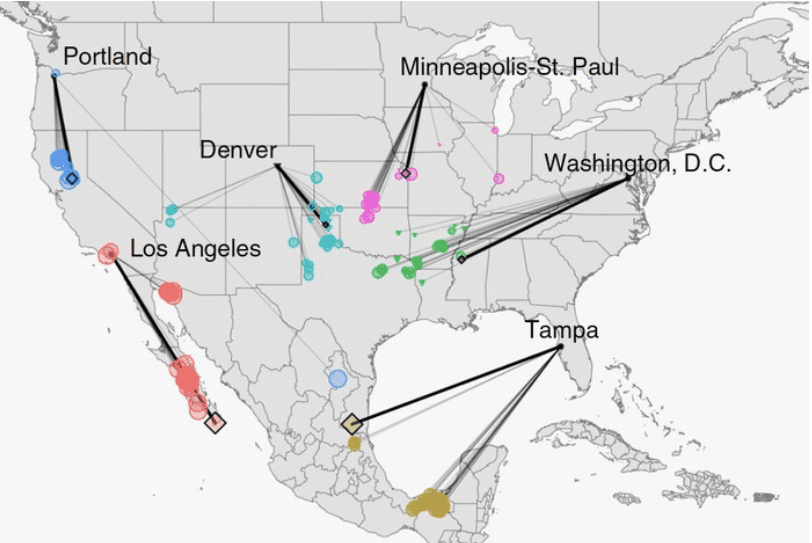
Photo Credit: University of Maryland Center for Environmental Science
According to the research, here’s what what it might feel like Los Angeles in 60 years.
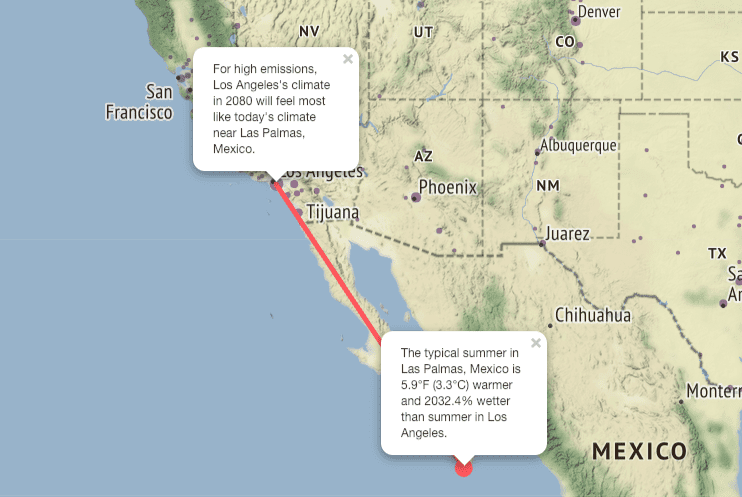
Photo Credit: University of Maryland Center for Environmental Science
Here is a snapshot of the Southeastern United States, focusing on Charlotte, North Carolina.

Photo Credit: University of Maryland Center for Environmental Science
How will the Big Apple fare in 2080? Take a look.
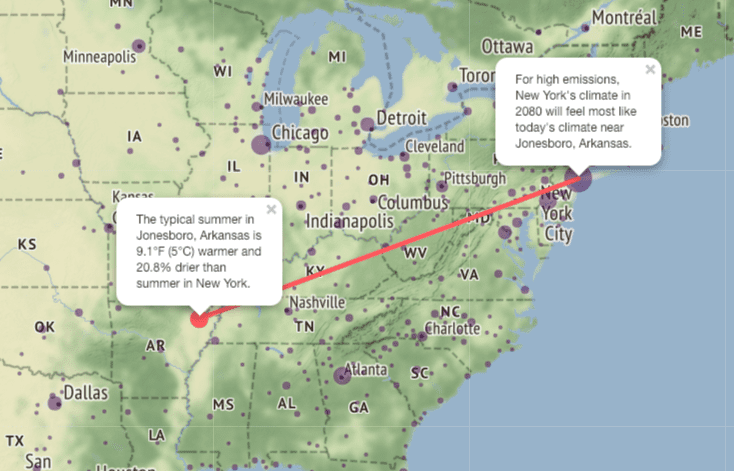
Photo Credit: University of Maryland Center for Environmental Science
NYC’s temperature will feel more like that of Jonesboro, Arkansas, which is more than 9 degrees warmer and 20% drier during the summer than the people of New York currently experience. And if you’ve ever been through a summer in New York, you know that if it got 9 degrees hotter…well, it’s pretty horrific to imagine.
Chicago has been in the news lately for its extreme cold weather, but in 60 years the weather in the Windy City might feel more like northeast Kansas.
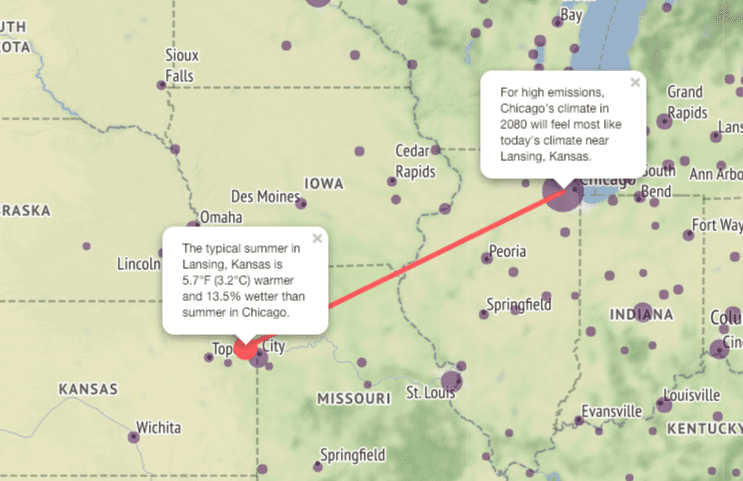
Photo Credit: University of Maryland Center for Environmental Science
As if Dallas wasn’t hot and sticky enough in the summertime, in 2080 the climate might feel more like that of New Orleans.
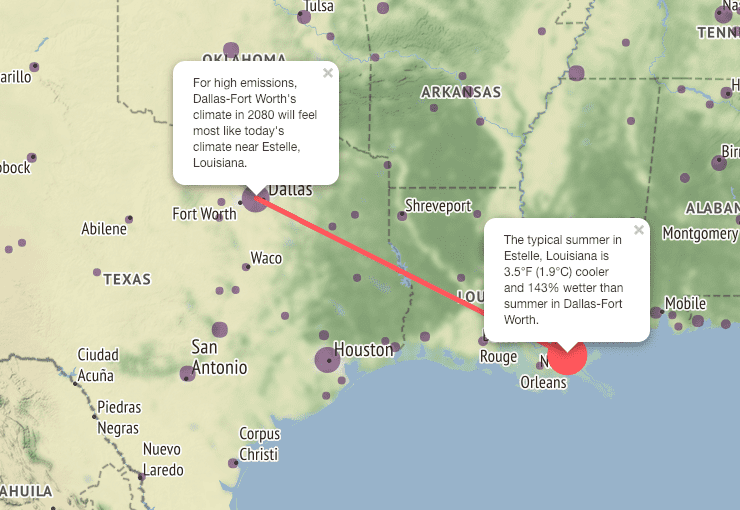
Photo Credit: University of Maryland Center for Environmental Science
A final example from the 2080 map, from Miami, Florida:
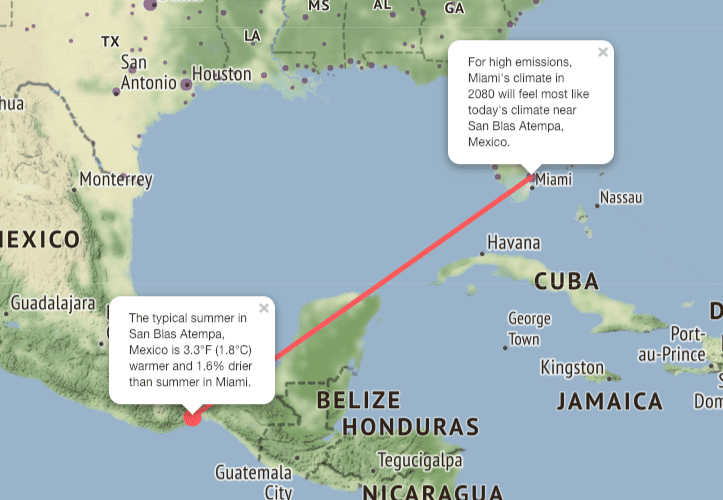
Photo Credit: University of Maryland Center for Environmental Science
The map from the National Oceanic and Atmospheric Administration, which is a little more difficult to figure out, allows you to explore how climate change might affect cities and towns in the U.S. from 2010 to 2100 and also offers historical climate data from 1950 to 2010. Here is an example.
The average daily maximum temperature in for Cook County, Illinois (which includes Chicago).
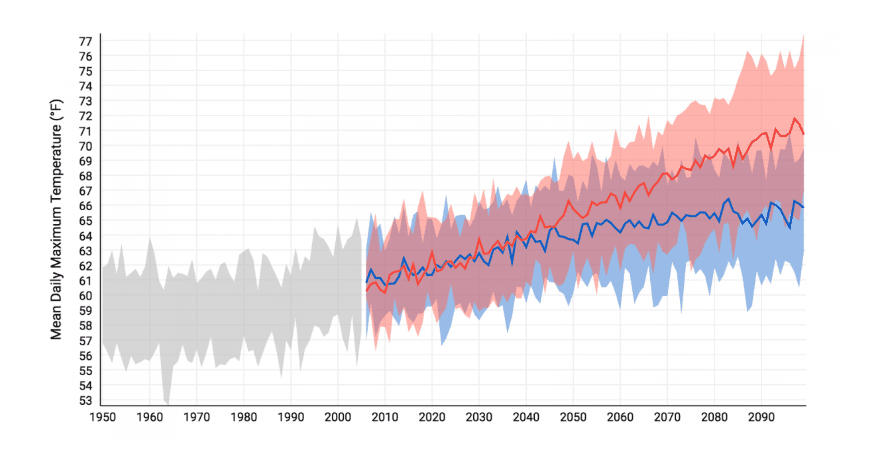
Photo Credit: NOAA
As you can see, it’s already warmed up, and it’ll just keep on getting hotter and hotter.
Look, the more we know about climate change, the better – and that means politicians, scientists, and normal citizens like you and me. It’s no longer an excuse to say “I’m not a scientist,” cause the scientists have made maps that do all the work for you. We’re not gonna solve this problem on a small individual scale. It’s time to pull together folks!
The post Interactive Maps Show How Climate Change Could Affect Your City appeared first on UberFacts.
1816 was called “The Year Without a Summer…
1816 was called “The Year Without a Summer” after the eruption of Mount Tambora in Indonesia. Crop failure forced Joseph Smith to leave Vermont, and his journeys resulted in “The Book of Mormon,” the dreary rain in Switzerland drove Mary Shelley to stay indoors, where she wrote “Frankenstein.” 10
